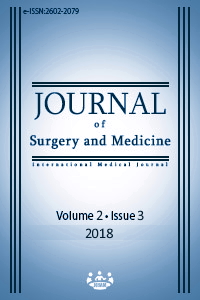A case-control study on rosacea and vitamin D levels
Keywords:
Rosacea, Vitamin D, Cathelicidin, ParathormoneAbstract
Aim: Rosacea is a chronic inflammatory dermatosis characterized by several features such as temporary erythema (flushing), permanent erythema, papules, pustules and telangiectasia in the face. In this study, our aim is to investigate the role of serum vitamin D levels in the pathogenesis of rosacea.
Methods: 50 patients with rosacea and 50 age and gender matched healthy controls were included in this study. In patients with rosacea and control group, serum parathyroid hormone (PTH), vitamin D levels and serum calcium levels were measured and the results were compared statistically.
Results: Serum vitamin D levels in patients with rosacea were significantly higher than the control group (respectively 10,55 ng/ml and 8,50 ng/ml). The median of serum calcium level was found to be 8,20 mg/dl in the group of patients with rosacea and 8,55 mg/dl in the control group. Serum calcium levels of the control group were significantly higher than the group of patients with rosacea. There was no statistically significant difference in terms of serum parathormone levels between the group of patients with rosacea and control group. The increase in serum vitamin D levels may lead development of rosacea.
Conclusion: As a result, the increase in serum vitamin D levels is associated with rosacea.
Downloads
References
Two AM, Wu W, Gallo RL, Hata TR. Rosacea: part I. Introduction, categorization, histology, pathogenesis, and risk factors. J Am Acad Dermatol. 2015;72:749-58.
Picardo M, Eichenfield LF, Tan J. Acne and Rosacea. Dermatol Ther (Heidelb). 2017;7(Suppl 1):43-52.
Wilkin J, Dahl M, Detmar M, et al. Standard classification of rosacea: Report of the National Rosacea Society Expert Committee on the Classification and Staging of Rosacea. J Am Acad Dermatol. 2002;46:584-7.
Rainer BM, Fischer AH, Luz Felipe da Silva D, et al. Rosacea is associated with chronic systemic diseases in a skin severity-dependent manner: results of a case-control study. J Am Acad Dermatol. 2015;73:604-8.
Mikkelsen CS, Holmgren HR, Kjellman P, et al. Rosacea: a Clinical Review. Dermatol Reports. 2016;8:6387.
Mostafa WZ, Hegazy RA. Vitamin D and the skin: Focus on a complex relationship: A review. J Adv Res. 2015;6:793-804.
Bikle DD. What is new in vitamin D: 2006-2007. Curr Opin Rheumatol. 2007;19:383-8.
Schauber J, Gallo RL. The vitamin D pathway: a new target for control of the skin's immune response? Exp Dermatol. 2008;17:633-9.
Lanoue J, Goldenberg G. Therapies to improve the cosmetic symptoms of rosacea. Cutis. 2015;96:19-26.
Yamasaki K, Di Nardo A, Bardan A, et al. Increased serine protease activity and cathelicidin promotes skin inflammation in rosacea. Nat Med. 2007;13:975-80.
Yamasaki K, Schauber J, Coda A, et al. Kallikrein-mediated proteolysis regulates the antimicrobial effects of cathelicidins in skin. FASEB J. 2006;20:2068-80.
Koczulla R, von Degenfeld G, Kupatt C, et al. An angiogenic role for the human peptide antibiotic LL-37/hCAP-18. J Clin Invest. 2003;111:1665-72.
Morizane S, Yamasaki K, Mühleisen B, et al. Cathelicidin antimicrobial peptide LL-37 in psoriasis enables keratinocyte reactivity against TLR9 ligands. J Invest Dermatol. 2012;132:135-43.
Schauber J, Dorschner RA, Coda AB, et al. Injury enhances TLR2 function and antimicrobial peptide expression through a vitamin D-dependent mechanism. J Clin Invest. 2007;117:803-11.
Di Nardo A, Vitiello A, Gallo RL. Cutting edge: mast cell antimicrobial activity is mediated by expression of cathelicidin antimicrobial peptide. J Immunol. 2003;170:2274-8.
Jang YH, Sim JH, Kang HY, et al. Immunohistochemical expression of matrix metalloproteinases in the granulomatous rosacea compared with the non-granulomatous rosacea. J Eur Acad Dermatol Venereol. 2011;25:544-8.
Reinholz M, Ruzicka T, Schauber J. Cathelicidin LL-37: an antimicrobial peptide with a role in inflammatory skin disease. Ann Dermato.l 2012;24:126-35.
Mutgi K, Koo J. Update on the role of systemic vitamin D in atopic dermatitis. Pediatr Dermatol. 2013;30:303-7.
Heimbeck I, Wjst M, Apfelbacher CJ. Low vitamin D serum level is inversely associated with eczema in children and adolescents in Germany. Allergy. 2013;68:906-10.
Kim SK, Park S, Lee ES. Toll-like receptors and antimicrobial peptides expressions of psoriasis: correlation with serum vitamin D level. J Korean Med Sci. 2010;25:1506-12.
Ekiz O, Balta I, Sen BB, et al. Vitamin D status in patients with rosacea. Cutan Ocul Toxicol. 2014;33:60-2.
Downloads
- 2038 4008
Published
Issue
Section
How to Cite
License
Copyright (c) 2018 Gülhan Gürel, Müjgan Karadöl, Emine Çölgeçen
This work is licensed under a Creative Commons Attribution-NonCommercial-NoDerivatives 4.0 International License.















